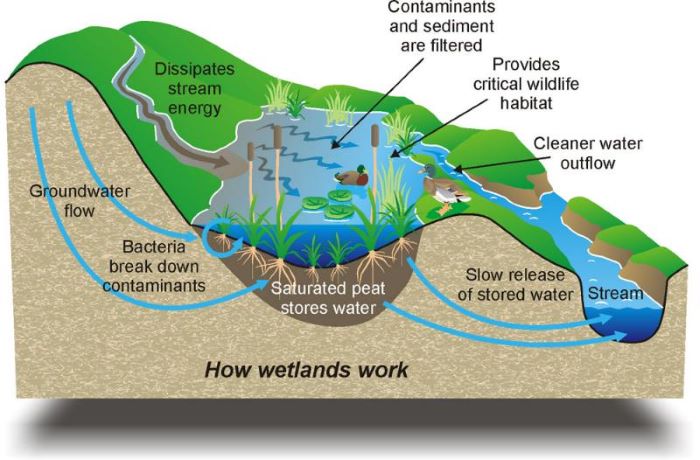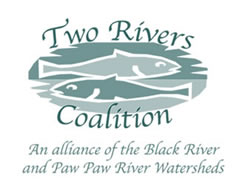|
Michigan's wetland statute, Part 303, Wetlands Protection, of the Natural Resources and Environmental Protection Act, 1994 PA 451, as amended, defines a wetland as "land characterized by the presence of water at a frequency and duration sufficient to support, and that under normal circumstances does support, wetland vegetation or aquatic life, and is commonly referred to as a bog, swamp, or marsh." The definition applies to public and private lands regardless of zoning or ownership.
Most people are familiar with the cattail or lily pad wetland found in areas with standing water, but wetlands can also be grassy meadows, shrubby fields, or mature forests. Many wetland areas have only a high ground water table and standing water may not be visible. Types of wetlands include deciduous swamps, wet meadows, emergent marshes, conifer swamps, wet prairies, shrub-scrub swamps, fens, and bogs.
|
Wetlands are a significant factor in the health and existence of other natural resources of the state, such as inland lakes, ground water, fisheries, wildlife, and the Great Lakes. Michigan's wetland statute recognizes the following benefits provided by wetlands:
- Flood and storm control by the hydrologic absorption and storage capacity of wetlands.
- Wildlife habitat by providing breeding, nesting, and feeding grounds and cover for many forms of wildlife, waterfowl, including migratory waterfowl, and rare, threatened, or endangered wildlife species.
- Protection of subsurface water resources and provision of valuable watersheds and recharging ground water supplies.
- Pollution treatment by serving as a biological and chemical oxidation basin.
- Erosion control by serving as a sedimentation area and filtering basin, absorbing silt and organic matter.
- Sources of nutrients in water food cycles and nursery grounds and sanctuaries for fish.
These benefits, often referred to as wetland functions and values, often play a vital role in recreation, tourism, and the economy in Michigan. According to a 1991 United States Fish and Wildlife Service Wetland Status and Trends report, over 50% of Michigan's original wetlands have been drained or filled, thereby making the protection of remaining wetlands that much more important.
Changes in Michigan's Part 301 (inland lakes and streams) and 303 (wetlands) in 2013
In 2003 the Federal Government, EPA required that Michigan's inland lakes and stream protection, part 301 and wetlands protection, part 303 comply with section 404 of the Clean Water Act. In 2009 the Michigan Legislature created the Wetland Advisory Council (WAC) to help make recommendations on legislation to bring Michigan into compliance. After several years of meetings and negotiations the WAC released its report on August 15, 2012.
On June 12, 2013 the Michigan Legislature amended and adopted SB 163 and sent the bill to the Governor for his signature. July 2, 2013, Governor Snyder signed Senate Bill 163 into law as Public Act 98.
Although Public Act 98 takes effect immediately the EPA as not officially gave it the stamp of approval.
Some useful guides:
Living With Michigans's Wetlands: A landowner's Guide
Michigan's Landowners are critical to the protection and management of wetland resources in the state. This guidebook contains information to help the landowner learn more about wetlands and the value of wetland protection, basic techniques and options for wetland management, the economic benefits of various protection methods, and where to go for more assistance.
Protecting Michigan's Wetlands: A Guide for Local Governments
This guidebook is designed for the local government official or interested citizen who faces important questions about wetlands. Why should you consider protecting them? It is hoped that the information contained in this guide will help you understand why wetlands are important; it provides information to help you make decisions about the wetlands in your local community. Tip of the Mitt Watershed Council
Helpful Links:
Wetlands Map Viewer
MDEQ Wetlands Website
MiEnviro Portal - Instructions for Minor Projects & General Permit Applications
|
|



